
Meet some of the millions of women who migrated recently, risking everything
In fear, hope, or desperation, these women left home seeking new lives. Some found opportunity; others found more uncertainty—or worse.
Raxma Xasan Maxamuud never wanted to leave her home in Somaliland. But a relentless cycle of droughts turned rivers to dust and dried up the grasses her livestock depended on. In Honduras, violence drove Kataleya Nativi Baca, a transgender woman, on a perilous journey to the United States border.
Women make up about half of those who migrate internationally and within their own countries. Some are pulled by the promise of a better future, but for those who face famine or danger in their home countries, migration is a gamble for their very survival.
Here, photographers with The Everyday Projects—a global network with a mission to challenge stereotypes by presenting diverse perspectives—explore how hardship and obligation, violence, poverty, climate change, and other forces undermine women’s lives, spurring them to make life-changing journeys.

The International Organization for Migration reported that 272 million people—130 million of them women—were living in a country not of their birth in 2019. More than 60 percent of those migrants live in Asia and Europe. Most international migration, however, is regional, with movement to and between countries in the Middle East, North Africa, and sub-Saharan Africa growing fastest.
In recent decades women increasingly have migrated to wealthy countries to become breadwinners themselves, rather than to join family members. They’re taking jobs in child- and eldercare and domestic work, as well as manufacturing and agriculture—a shift described as “the feminization of migration.” Migrant women living abroad are more likely to be overqualified for these jobs and earn less than men, and they send more of their incomes to families back home.
For women escaping violence or poverty, the clandestine routes they take increase their vulnerability to sex trafficking, assault, and rape. And for women going to countries with weak laws, or for women who are undocumented, securing basic rights may be impossible.
Forced migration of refugees and asylum seekers rose by an average of 8 percent a year from 2010 to 2017, compared with less than 2 percent for international migration. Of the 33.8 million people forced to migrate abroad in 2019, nearly half were women. That year another 33.4 million people, more than half of them women, were forced to move within their own countries, 75 percent of them because of natural disasters. (This is what 50 years of human migration looks like.)
The World Bank estimates that in 2020, the COVID-19 pandemic led to an unprecedented 20 percent drop in global remittances to home countries. Fear, anger, and poverty are inflaming resentments and xenophobia, and migrants are often scapegoated as disease vectors or blamed for social ills exacerbated by the pandemic.
The stories that follow illustrate facets of the relocation experience for women migrants: the decision to leave, the hope and hardship of the journey, the adjustment to a new life, and more.
WOMEN ON THE MOVE
In recent years millions of women have left their homes, traveling between villages and cities, and across borders, in pursuit of new lives. Click below to jump to other chapters:
Move—or Die ► The Journey ► The Contract ► Finding Peace ► Xenophobia ► Misson to Educate ► New Choices ► The Art of Healing
Chapter 1. Move—or Die: She lost nearly everything when drought killed her livestock in Somalia. Now she bides her time in a camp for displaced people.
Photographs by Nichole Sobecki
The sheep were the first to start dying. Unable to find enough grass to eat, they’d grown thin and listless, their bleats fading. “They were just dying around us like something poisoned,” Raxma Xasan Maxamuud says. Pastoralists in the village of Haya, in central Somaliland, an unrecognized, self-declared state within Somalia, Raxma and her family raised 300 goats and sheep and 20 camels. Within four weeks of drought in 2016, all their animals had died.

Seminomadic Somali pastoralists, who tally the passage of years by the regular arrival of the rains, began to notice that during the past 20 years the rains were erratic, no longer aligning with other rhythms of life, such as when their animals gave birth. “If anybody still doubts climate change,” says Sarah Khan, head of the Hargeysa suboffice of the United Nations High Commissioner for Refugees, “they just have to come here.”
Raxma says she’s about 36 years old. She was born in the year her community named biyo badan, “a lot of water.” In her lifetime, severe droughts used to occur about twice a decade, but punishing drought in 2016 and 2017 destroyed an estimated 70 percent of Somaliland’s pastoral economy, the primary industry. Rain-fed rivers and lakes that had sustained generations of pastoralists disappeared. In Haya in 2016, the wells went dry for the second time in five years.



The town hired trucks to bring water in from another city, but mostly “we felt thirsty,” Raxma says. Villagers didn’t wash their clothes. And unlike during the year of plenty Raxma was born into, they didn’t name the bad years, hoping those times would be forgotten. “The life we had before was like living in a castle,” Raxma says. “We sold goats and had meat and butter. We didn’t need anybody’s help. We used to help others because we had too much.”
Somali pastoralists measure wealth not by what they can buy but by the size of their herds. Losing your livestock is akin to having your house burn down, your car stolen, and your bank account emptied on the same day.
In Haya the smell of death from thousands of rotting carcasses hung in the air, but for three months, as the drought of 2016 deepened, Raxma’s family held on. Families with surviving camels shared milk with those whose herds had died. As food dwindled, adults saved the largest portions for the youngest children. Diarrhea spread, Raxma says, and people feared for their lives. With all their animals now dead, the villagers pooled their money and rented a truck to take them to an IDP (internally displaced persons) camp near Burco, in central Somaliland.
The World Bank estimates that by 2050, 143 million people in sub-Saharan Africa, South Asia, and Latin America will be forced to move within their own countries because of climate conditions. Today Raxma and as many as 600,000 people in Somaliland are stranded in camps, dependent on humanitarian aid to eat and drink.
Raxma hasn’t given up hope. She named her youngest daughter, who was born in the camp, Barwaaqo, a word that evokes prosperity, abundance, and the happiness felt when the herds are healthy, the rains plentiful, and the lands green. Raxma lost nearly everything, but her daughter’s name is an expression of gratitude that her family’s survival is its own kind of wealth. Back to top
Chapter 2. The Journey: Fleeing danger at home in Honduras, she braved a perilous trip to the U.S.-Mexico border—only to find more violence and uncertainty.
Photographs by Danielle Villasana
Before Kataleya Nativi Baca left Tapachula, Mexico, she called her sister from the apartment she was sharing with two other migrants from Central America. “Tomorrow I’m going to be a lot farther away,” she said.
Kataleya, 28, a transgender woman, was a pariah in her hometown of San Pedro Sula, in Honduras. Her mother rejected her. Her brother beat her. In a country where spiraling violence is fueled by machismo—exaggerated expressions of masculinity—hundreds of lesbian, gay, bisexual, transgender, and intersex people are harassed, often violently. A network of rights groups found that more than 1,300 of these individuals have been killed in Latin America and the Caribbean since 2014, 86 percent in Colombia, Mexico, and Honduras. For many, braving the dangerous journey to seek asylum in the U.S. is preferable to facing dangers at home.



Tapachula, a border city in southern Mexico, is a hub for migrants from Central America, the Caribbean, and Africa. Kataleya spent four months there until she received a visa to transit through Mexico to Tijuana, at the U.S. border.
Before boarding the bus, Kataleya said bittersweet goodbyes to people she passed on the street, the security guard at her favorite fast-food spot, her roommates—strangers who’d become friends in the shared challenge of escape. “Finally I’m out of Tapachula,” she said.
The bus was full—mostly men, women, and children dreaming of a new life. The driver flipped the air conditioner on and off to save gas. Cell phones hung from shared power strips overhead. The riders made grainy video calls.


Immigration officers soon stopped the bus to check the passengers’ papers—the first of 20 stops and checkpoints that set a rhythm of disruption and anxiety for the next 72 hours and 2,500 miles. Many migrants who can’t secure transit papers through Mexico hitchhike or walk to avoid authorities and the risk of jumping a train. They’re exposed to gang violence, sexual assault, extortion, recruitment from organized crime, and kidnapping. Kataleya was lucky: She had papers.
By the third day, the smell from the toilet was so bad that people clapped cloths over their noses each time the door opened. Backpacks and purses bulged with rumpled clothes and toiletries. Kataleya cleaned herself with wet wipes and reapplied her lipstick. Hours out of Tijuana, the bus roused in a commotion. The migrants pressed against the windows, squinting at a metal line snaking across the expanse of yellow grassland—the U.S. border fence.
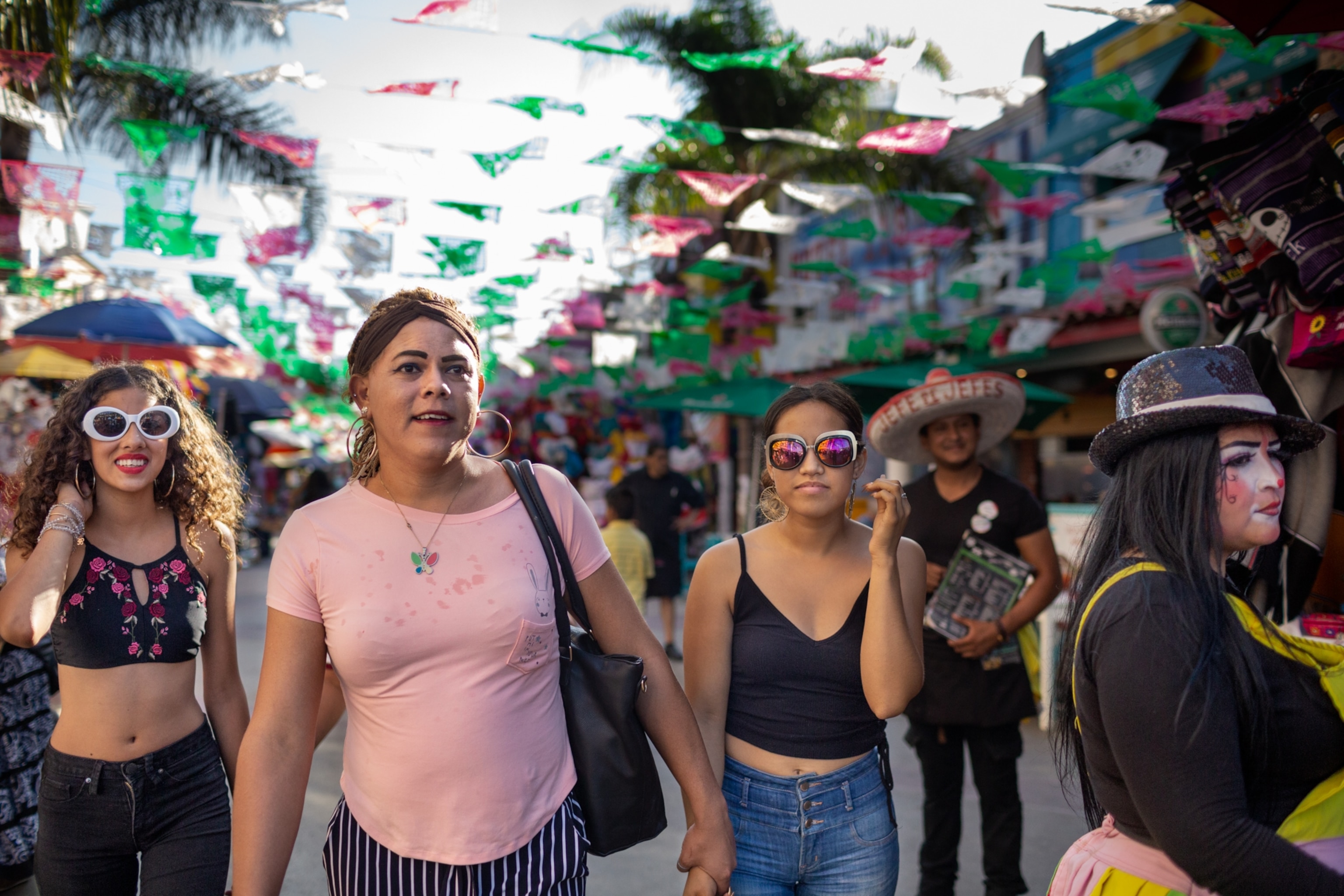

In Tijuana, Kataleya was given a number to have her asylum case heard: 4,050. At the time, the authorities were processing 2,925. Six months later, and roughly two weeks before her number was supposed to come up, the U.S. government closed the border to immigration because of the COVID-19 pandemic, halting asylum claims.
Facing uncertainty and violence at the border in Mexico, and rejection at home, Kataleya finds that the hope that propelled her on her journey to the U.S. has been replaced with a dread in the pit of her stomach she can’t escape. Her limbo has included being robbed and beaten in shelters for LGBTQ migrants. At other times, she’s depended on support from different men. Despair has set in. “From morning to night,” she says, “everything fell apart.” Back to top
Chapter 3. The Contract: Determined to find financial security, she risked leaving her home in rural Vietnam for a brokered marriage to a man in Singapore.
Photographs by Amrita Chandradas
On Ngoc Tuyen’s wedding day she was surrounded by strangers. She sat on a wooden bench in Singapore’s botanical garden, in a red dress with black lace trim and a headband with beaded daisies. She’d met the groom two months earlier, and his family only after she arrived 16 days before. A marriage broker translated the ceremony into Vietnamese, and they sealed their commitment with a stiff kiss on the lips. After a flurry of paper-signing, Tuyen’s marriage was official. “It’s such a good start,” Tuyen says. “I want to work soon.”
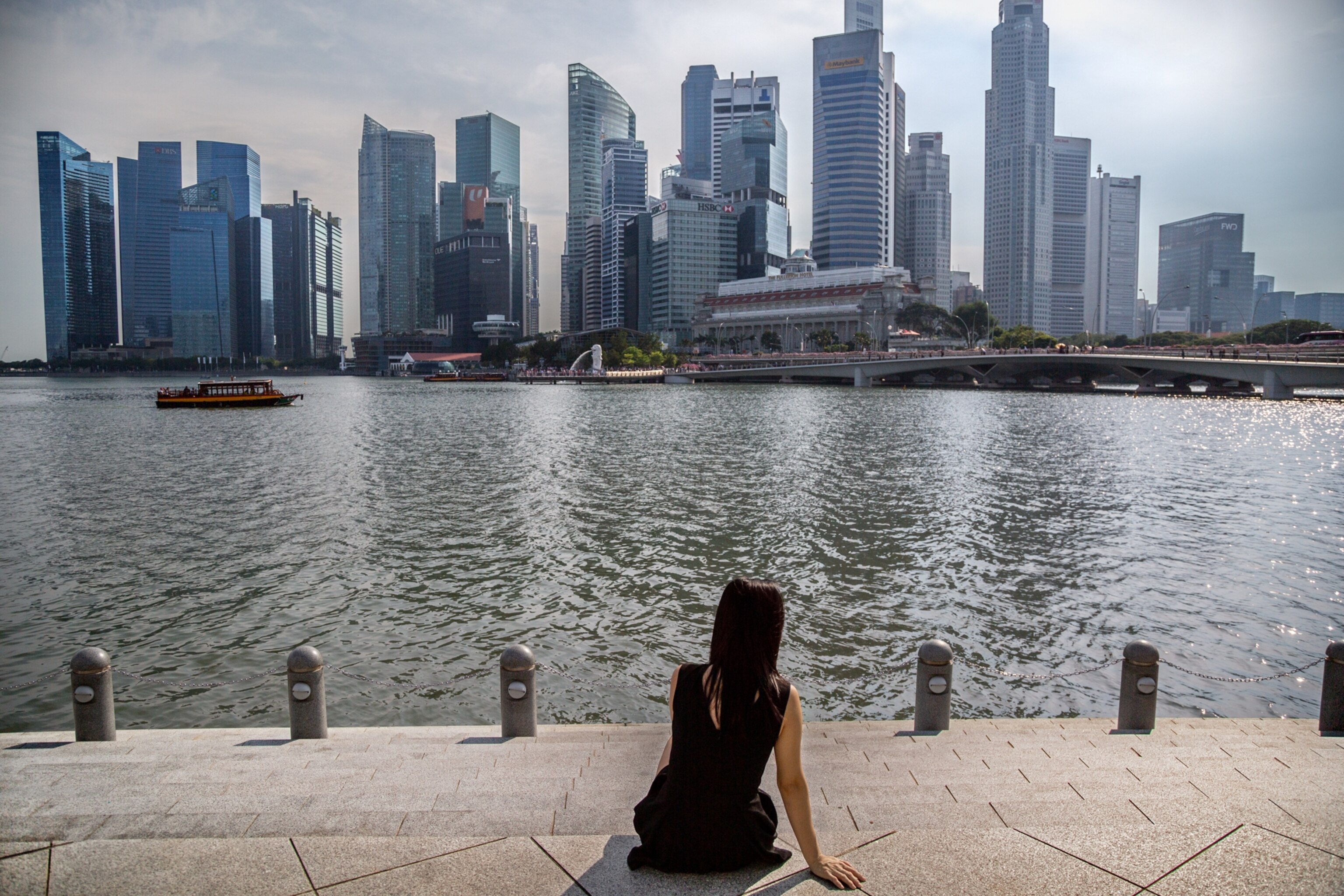
Tuyen is a marriage migrant—one of tens of thousands from Vietnam during the past decade, most of them women. It often starts with marriage brokers who alert women in villages and provincial towns about men visiting from South Korea, China, Taiwan, Singapore. This is how Tuyen, 34, met Tony Kong, 45. His photo popped up on a broker’s Facebook feed, with an address in Ho Chi Minh City and a date when he’d be viewing and interviewing potential wives. The terms are clear: Women come prepared to negotiate stipends for themselves and their families, and the men state their salaries. In exchange for their beauty, youth, and companionship, the women want financial stability—and in Tuyen’s case, the chance to work and send money home to her family. Remittances are crucial in poor, rural parts of Vietnam.


“It’s not about love,” says Mark Lin, a matchmaker and proprietor of the Singaporean marriage agency True Love Vietnam Bride. Asked if his male clients are handsome, Lin grimaces before arriving at a diplomatic answer: “It depends.” Lin knows that his industry trades on economic disparity. In Singapore, the average annual income is $92,000; in Vietnam, it’s $7,750. Whatever flaws prevent his clients from finding Singaporean women to marry, at least they have more money than their Vietnamese counterparts.
Tuyen asked Tony for a monthly stipend of $370, which he negotiated to $220, the amount she’d earned working at a food stall back home. It’s not enough to support her family, but she’s hoping that if her work permit is approved, she’ll find a job at a nail salon and be able to send money back to her parents and her five-year-old son.


For a migrant wife to stay and work in Singapore, she must first apply for a long-term visit pass, which is renewed by her husband every one to two years. If he doesn’t, the woman loses not only her papers but also possibly any children born from the marriage. Courts routinely grant custody to the Singaporean parent, as children benefit from being Singaporean citizens. Their mothers, who depend on their husbands to remain in Singapore, may endure abuse, neglect, and infidelity, according to news reports and organizations that provide support services.
Tuyen, who speaks halting Mandarin with Tony, says she doesn’t know what her new husband needs from her, so she cooks for him and keeps him company. She doesn’t know if or when she’ll get her long-term visit pass. That depends on the husband’s monthly salary, and Tony has been out of a job. Tuyen doesn’t know if her son will be able to join her in Singapore or if she’ll be able to support him.
But on her wedding day, Tuyen was willing to play the role of a newlywed. “I’m very happy,” she said. Then, once again, she asked the translator when she’d be allowed to work. Back to top
Chapter 4. Finding Peace: After escaping religious persecution in Myanmar and enduring a harrowing voyage, she and her family have found freedom and support in Australia.
Photographs by Mridula Amin
At first Sajeda Bahadurmia, then 26, didn’t know if the men in uniform would hurt her. It was 2013, and she’d spent 14 days, from April 23 to May 6, in a boat with her husband, Nayim Ullah, and four children, sputtering across the Timor Sea from a port city in Indonesia to Darwin, on the northern tip of Australia.

The 150-foot boat was packed with more than 100 migrants—Rohingya people like them, fleeing oppression in Myanmar, as well as dozens of Bangladeshis and two Somalis. Each time a powerful wave crashed against the hull, she held her breath and kept her year-old son tied tightly to her waist as sharks circled in the dark water. Her daughter, Asma, who was 10, asked, “Are we all going to die?”
“That’s ingrained in my brain,” Sajeda says. “I thought: If Allah saves me, I’m never putting my children in danger again.”
When the Australian Navy picked them up, she didn’t know if the sailors would beat her, insult her, or grope her the way the Myanmar military had back home. But they were gentle, she says. They respected Muslim customs, and women carried out health checks on the refugees, who were taken to a detention center in Darwin.

The Myanmar government has long persecuted the Rohingya, a Muslim ethnic minority. Violence starting in 2012 prompted Sajeda and her family to leave, and by the end of 2017, about a million Rohingya had fled to neighboring Bangladesh and elsewhere. (See the refugee babies born with nowhere to call home.)
“You can’t trust the nights,” Asma, now 16, recalls of the times when military men would burst into their homes. They violated women and dragged men into the street, arresting them or sending them into forced labor. The Myanmar government banned the word “Rohingya.”
During their three months at the detention center, Asma and Sajeda were offended that the authorities addressed them by numbers according to the boat they’d arrived on: ROM006 and ROM007. Even so, they soon began stepping into their new life. When Asma started going to the public school, she didn’t speak English, but she smiled and laughed across the table with her Australian classmates as they ate sausage sizzle.
“I became very obsessed with it in Darwin,” Asma says.


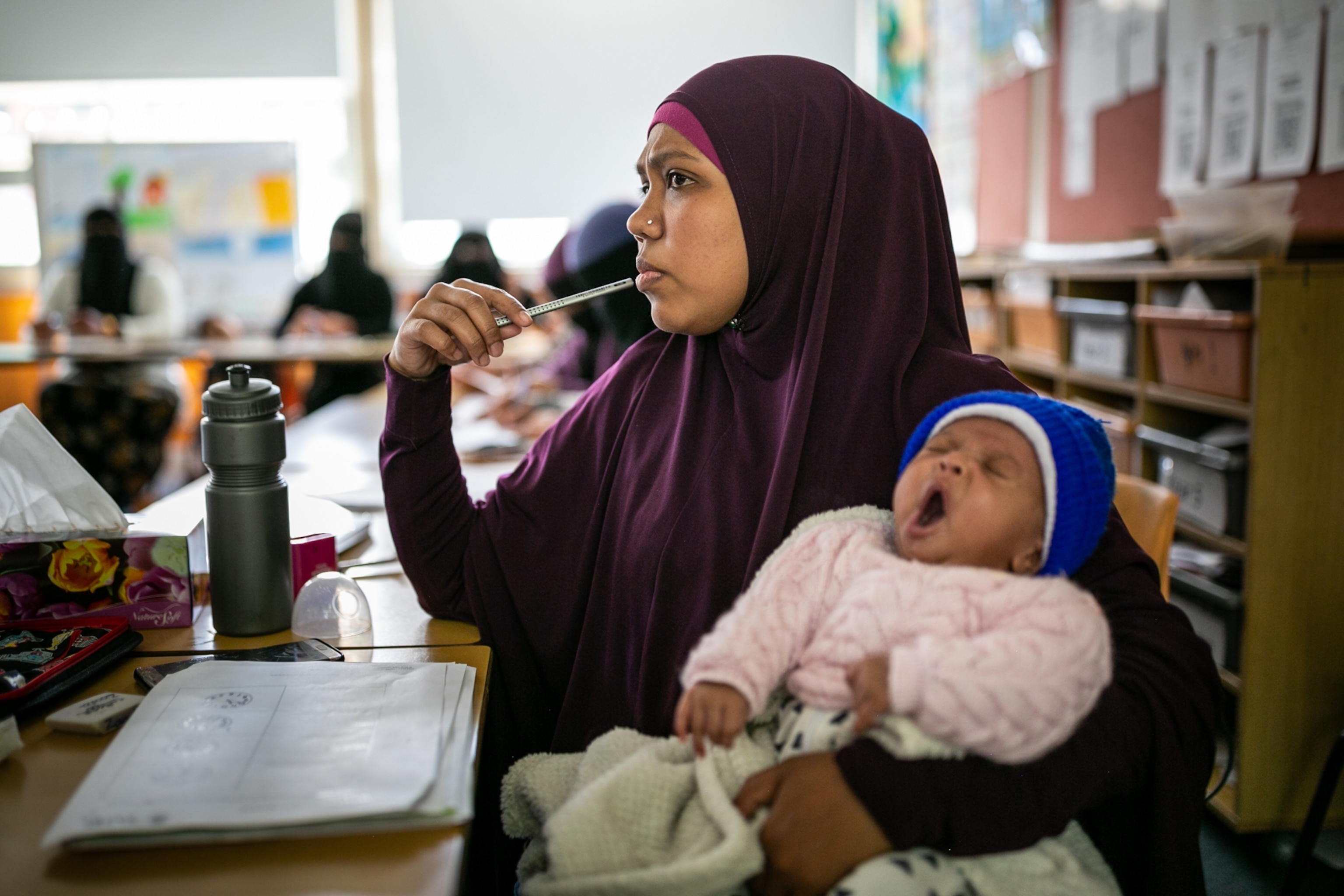
Eventually Sajeda, now 32, and her family were resettled in Sydney under an Australian program that paid for their flights and subsidized their first months of living expenses. As refugees, they were eligible for government aid. Sajeda discovered ketchup and fell in love with Australian barbecue. She volunteered at a community kitchen, got a part-time job at her children’s school, and learned to drive. The family moved into a new home in Lakemba, a Sydney suburb where Rohingya was spoken in the streets. She saw the joy in her children’s eyes when they opened the door to their first house.
“The word ‘freedom’ just came out of nowhere,” Asma says. “I’m meant to be here. That sense of belonging was overflowing in me.” In Myanmar, those who spoke out could be killed. In Australia, Sajeda heard people voicing their thoughts, and she did the same. Standing outside the mosque in Lakemba, seeing Muslims spilling out into the street after prayers, she marvels at the sight: “I’ve never got to see that,” she says. Back to top
Chapter 5. Xenophobia: Women from Central Asia moving to Russia to find work confront violence and prejudice.
Photographs by Ksenia Kuleshova

Zhibek Turgunbaeva, 37, who arrived in Moscow from Kyrgyzstan in December 2007, knows the hatred that being an outsider can elicit. And the kindness too.
“You churka [literally ‘block of wood,’ meaning Central Asian moron]!” she says a woman on the subway called out one September day in 2019. “Stand up!” the woman snarled. “It makes me sick that you are sitting here.” Immigrants are “like sheep. They are stupid,” the woman went on. Then came threats: “I will find you,” she told Zhibek. “If not, the people from your country. I will ask someone to beat them up and kill them. We’ve had enough. Moscow isn’t for your kind.”
As the train pulled in at the next stop, passengers took hold of the woman and hustled her onto the platform. A Russian man soothed Zhibek, who was crying. She says the man told her there are many idiots around, and that she shouldn’t let them weaken her.

Russia’s booming economy has drawn a flood of newcomers from Central Asian countries during the past two decades. Of the 11.6 million foreigners in Russia in 2019, the greatest numbers were from Kyrgyzstan, Kazakhstan, Tajikistan, Turkmenistan, and Uzbekistan. Most came looking for work and took jobs in the construction and service industries, says Anna Rocheva, who researches Central Asian migration, gender, and integration at the Russian Presidential Academy of National Economy and Public Administration, a university in Moscow.
Citizens of Kyrgyzstan and Kazakhstan, member countries in the Eurasian Economic Union, are permitted to work in Russia with the same standing as Russian citizens. Those from other Central Asian countries must secure work permits, which cost 5,000 rubles (about $65) a month. (Since COVID-19 took hold, Russia’s borders have been closed to most Asian countries.)
“Migration is a win-win” in the economic sense, Rocheva says. But many migrants have been met with xenophobia—fear or hatred of the “other”—hostility, and discrimination, she says. They’re denied jobs and apartments. Some have been beaten and killed by marauding gangs.

According to Rocheva, Russian police often harass migrants, demanding their work permits, threatening to detain them for hours, making them late for work. This is illegal, but migrants unaware of their rights—who may fear being fined by their employers or fired for being late to work—may pay bribes to be released.
“When Central Asian migrants come, they are Muslim; they are not Russian,” Rocheva says, describing part of what explains the violence and vitriol leveled against them. Russians complain that migrants don’t speak their language, spoil their culture, and take their jobs, Rocheva says. “In this sense, every country is the same—when people are xenophobic, they say the same things.”
According to the Moscow-based Levada Center, which conducts annual polls tracking Russian sentiments toward foreigners, xenophobia peaked a decade ago and then declined somewhat.
But by 2019, hate was on the rise again, despite increased police enforcement against extreme racist groups. A Levada Center report that year found that one out of two people supported the slogan “Russia for Russians,” while 71 percent said there were too many foreigners in the country.
In a statement at the time of the report’s release, Karina Pipia, a sociologist with the Levada Center, said that growing concern about poverty among Russians during the past three years may have contributed to negative attitudes toward migrants, whom some Russians blame for a shortage of jobs.
“I didn’t know there were ‘wrong’ nationalities,” says Guliza Akmatsiyaeva, who was 22 when she moved to Russia from Kyrgyzstan during an economic crisis in 2007, hoping to earn money to send back to her family.
She says she learned that hard lesson in Moscow, where she thought she stood out because of her Asian features, typical of Kyrgyz people. At the shop in the market where she worked, strangers walked up to her, hissing, “Go home!” and hurling racist slurs. “I felt like everyone around hated me,” Guliza says. “I was afraid that literally anyone could come and hit me in the face.”


One evening in 2016, Guliza says, masked assailants stole the money from the shop, smacked her with a gun, and beat her. When the shop owners arrived, she recalls their suggesting that because Guliza wasn’t Russian, she had organized the robbery—and her own beating—by migrant friends.
She says the police dismissed her report with a similar argument, despite closed-circuit security video that showed the assailants forcing their way into the shop. When ambulance workers arrived, they refused to treat her, Guliza says.
“They said I didn’t have the right citizenship,” she says. “They were just standing there laughing; then they left. It was horrible.” A policeman she knew from the neighborhood gave her a sedative. Guliza never went back to the shop, and it took her more than a year, she says, to recover from the trauma.
“Even now when I look for an apartment to rent, I go to the websites, and the listings say, ‘No Asians,’ ‘Asians don’t bother,’ or, ‘Only for Russians,’ ” Guliza says. “They were saying very openly, Your face doesn’t fit.”

Newcomers to Russia often grasp for ways to cope and stay safe. Zhibek bleached her black hair blond to try to shield herself from racist attacks. Since she did that, she says, police have stopped harassing her, though other migrant women she works with from Moldova and Ukraine continue to be targeted.
Amid the hostility, some newcomers find solace—and material support—from fellow migrants and their mosque communities. “The mosque always helps,” Zhibek says. Her mosque gave her money and food when she arrived in Moscow and didn’t yet have a job. And during the pandemic, she says, another mosque has taken in migrants who’ve become homeless and delivers meals to those who’ve lost their jobs. “It’s not just financial help,” Zhibek adds. “It’s the moral support from the mosque that is so important.”
Two Kyrgyz women in Moscow, Venera Bokotaeva, 40, and Shahrizada Adanova, 26, started support and skills training groups for fellow migrants. Venera established one called Bakyt—Kyrgyz for “happiness.” “I wanted to see women with happy eyes,” she says, “and I decided to start this group to help them.”

About a thousand women are now members of a Bakyt WhatsApp group, where they find a sense of community and arrange get-togethers, such as the time 90 women showed up at a Kyrgyz teahouse in the city, sharing platters of plov, an Uzbek dish of rice and meat. Shahrizada set up an online support group for Kyrgyz and Uzbek women where they can exchange helpful information—recipes, for example—and messages of motivation or empowerment.
Guliza, who studied law in Kyrgyzstan before moving to Moscow, went on to earn a master’s degree in law at the Russian State Social University. That led to a position as a lawyer with a real estate company in the city. She does pro bono work on the side for migrants, helping them recoup unpaid wages and advising them on how to assert their rights when they’re stopped arbitrarily by police. Don’t be rude, she advises—ask about the grounds for detention, and if the officers do something illegal, live-stream the encounter immediately. Guliza also formed a WhatsApp group, where she sends out warnings on days, such as April 20—Adolf Hitler’s birthday—when it may be dangerous for migrants to go out in public.
Zhibek Turgunbaeva says that whatever suffering or unhappiness she encounters in Moscow, the reason for being there remains the same. “I just want to make the money I need as soon as possible and leave. I really want to leave. If I had my own house back home, I wouldn’t have thought about staying even for a second, because I haven’t seen my children grow up.” Back to top
Chapter 6. Mission to Educate: A Zimbabwean woman establishes a school in Johannesburg, South Africa, so disadvantaged children can become ‘self-reliant and self-sufficient.’
Photographs by Miora Rajaonary
Judith Manjoro was a high school teacher in Zimbabwe. She had no intention of leaving her country, but when tensions between the government and an opposition group she supported erupted into violence in 2005, she fled for Johannesburg, South Africa’s boisterous, booming hub of 5.7 million people.
There, Judith, now 55, took on various jobs available to migrants: cleaning houses, doing laundry for families of means, selling Tupperware on the street. Eventually, she was granted asylum.

It was in 2009 during her afternoons off as a domestic worker, she says, that she noticed Congolese, Burundian, and Zimbabwean children out on Johannesburg’s streets and in parks, unsupervised and rootless. She asked them why they weren’t in school.
“Children of migrants, especially those with no documentation, would find it was impossible to get into school,” Judith says.
South African law states that all children should have access to public education. But securing the right documents to enroll foreign children in schools has long been difficult, so much so that in a 2019 report, the South African government identified the problem as a form of institutional xenophobia. As a result, tens of thousands of undocumented children have been unable to go to school.
Judith decided to link up with a fellow Zimbabwean, Siboniso Mdluli, 58, who’d taught primary school back home, “to use our time to take care of this need that we can see.” They started an informal study group for out-of-school children and spent the day teaching lessons the students would have learned in formal school. “Parents saw what we were doing,” Judith says, “so they just kept bringing their kids.”
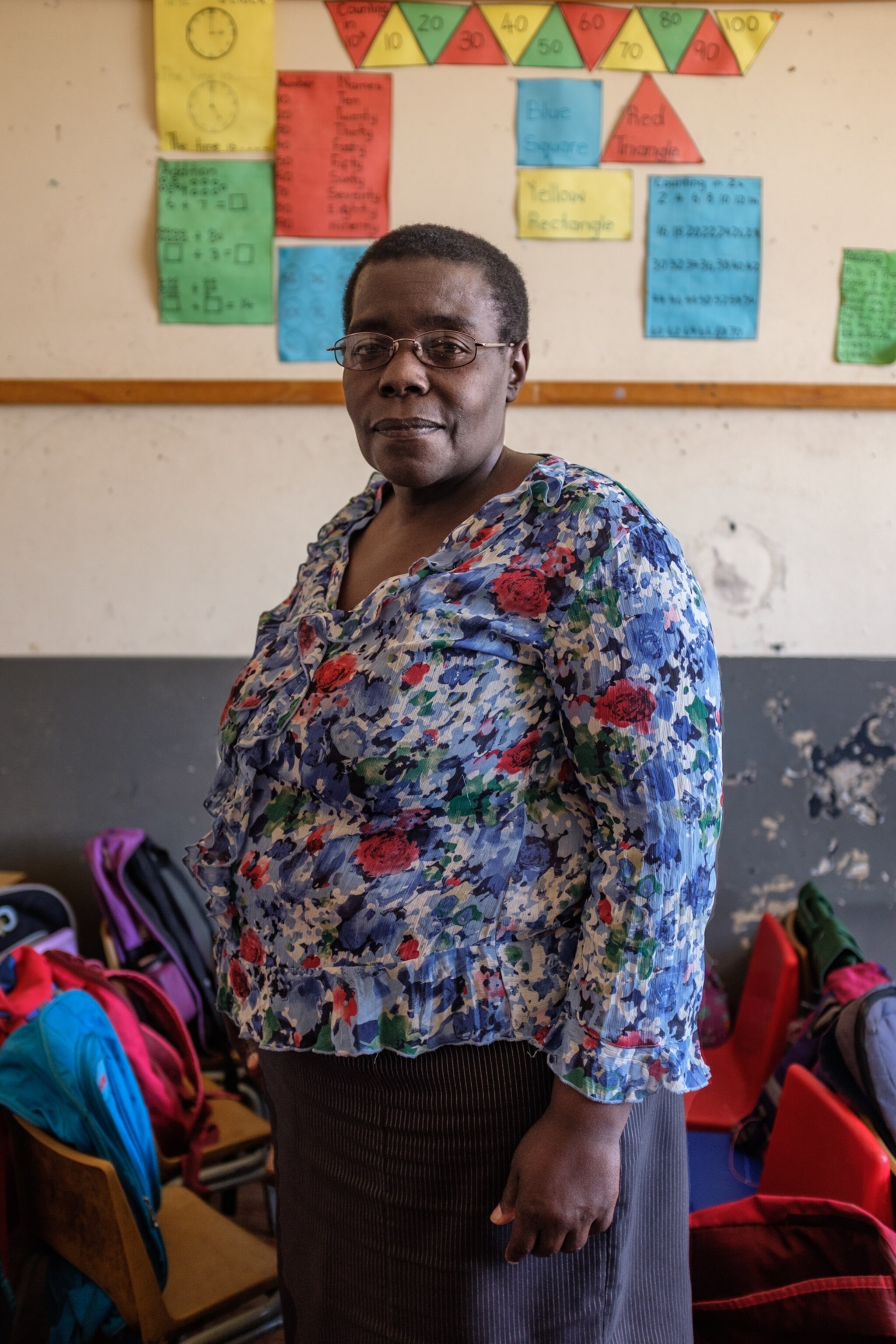
As the numbers grew, their effort attracted the attention of officialdom, and early in 2012, Judith and Siboniso were arrested for operating an illegal school and taken to a holding cell. Judith says she was able to pay her bail and was released but that Siboniso was jailed for several weeks. For about a year, they were in and out of court before their case was dismissed without an explanation.
Judith guesses the authorities concluded that what they were doing was “beneficial to the community” and that they should be allowed to keep going.
The two women began the process of making their school official. “As migrants,” Judith says, “it is for us to make the necessary arrangements for our kids to go to school.” They wanted to give youngsters opportunities to “become productive members of the communities in which they live so they become self-reliant and self-sufficient.” If later on they return home, Judith says, with an education it’s possible to build the future. “You can’t just go back home and become indigent again when you get there.”
Judith and Siboniso rented a building in Yeoville, a neighborhood of Johannesburg where many migrants live, and registered a school under the name Velamfundo, which means “arise with education” in Ndebele, a language spoken in Zimbabwe. By 2019, Velamfundo Primary School had some 350 students in eight grades, most of them children of migrants.

It was a struggle to open the school, Judith says, and “the struggle continues. Money is a huge, huge problem.”
As a private school, Velamfundo is funded entirely by the parents, most of whom have low-paying jobs—as security guards or street vendors eking out a living by selling items such as secondhand clothing.
Judith had hoped to secure funding from NGOs and philanthropic foundations, but no support was forthcoming. She says she keeps the fees as low as possible—450 rand, about $30, a month—and that the migrant community has scraped together enough to keep Velamfundo open.
In 2019, unemployment in South Africa rose to 29 percent, the highest in a decade. Then the coronavirus hit. In March 2020, South Africa imposed a strict COVID-19 lockdown, and schools, including Velamfundo, were required to close their doors and stop in-person teaching until August.
By December 2020, unemployment had increased to 31 percent, heightening the financial strain on millions of South Africans. Many undocumented migrants, ineligible for government food parcels, have gone hungry, and medical care has been out of reach.

Anti-migrant sentiment, which had simmered for decades and periodically erupted in targeted attacks and deadly riots, intensified. In a September 2020 report, Human Rights Watch documented new or resurging xenophobic hate groups that blamed migrants for the hardships South Africans faced. Judith says she saw online messages maligning migrants in Yeoville as criminals and openly calling for violence.
Dewa Mavhinga, southern Africa director for Human Rights Watch, says politicians have inflamed xenophobia by making speeches blaming migrants, who make up 7 percent of South Africa’s population, for the pandemic and calling for policies “to exclude foreign nationals.”
In May, the government began easing lockdown restrictions. Amid the fear, violence, and deepening financial hardship caused by the pandemic, Judith drew on her abundant resolve and self-reliance and scraped together enough money to gradually reopen the school. She’d used up her savings during the lockdown and didn’t have enough money to restart her Tupperware business, so she turned back to cleaning houses and doing laundry for families.
Velamfundo parents who’d lost their livelihoods began raising tuition money by doing odd jobs. Meanwhile, Judith says, the owner of the school building agreed that she should pay whatever rent she and the parents could afford. By August, Judith was hopeful that the school would survive.

But in December, a virulent new strain of the coronavirus forced another lockdown and pushed infections in South Africa to 1.2 million confirmed cases and more than 33,000 deaths. Schools, including Velamfundo, which are now on the summer holiday break, are awaiting word from the government about when they can reopen. Meanwhile, Judith says, whatever money parents may have saved for school fees is “going to be depleted. The money will be used for other immediate needs.”
Judith doesn’t turn students away when their parents can’t afford the fees, but her shortfall has been substantial since the lockdown in March 2020. The landlord has been generous, Judith says, but he still has to pay for electricity, water, and other building expenses. “Naturally, he can’t continue to support us from his own business,” she says.
After a decade of fighting for a safe place for migrant children to study, Judith is now faced with the possibility that Velamfundo may shut down permanently. “If the lockdown continues as it is,” she says, “then that risk is really alive.” Back to top
HOW TO HELP: For information about schools for migrant children in South Africa, contact organizations such as the African Diaspora Forum and the Scalabrini Centre of Cape Town.
Chapter 7. New Choices: Leaving the violence of their home city in Pakistan, they chose to pursue an education in Islamabad—and found a more open culture that inspired creativity and discovery.
Photographs by Saiyna Bashir
The city of Quetta, Pakistan, is surrounded by soaring, snow-dusted mountains. But Farheen, 22, never ventured into them. She avoided the city’s bazaars, made few friends, shunned boys. She loves to dance but only did so in front of the mirror at home; women in her culture can be shamed—or worse—for dancing. “I’m not conservative,” she says. “Just terrified.”
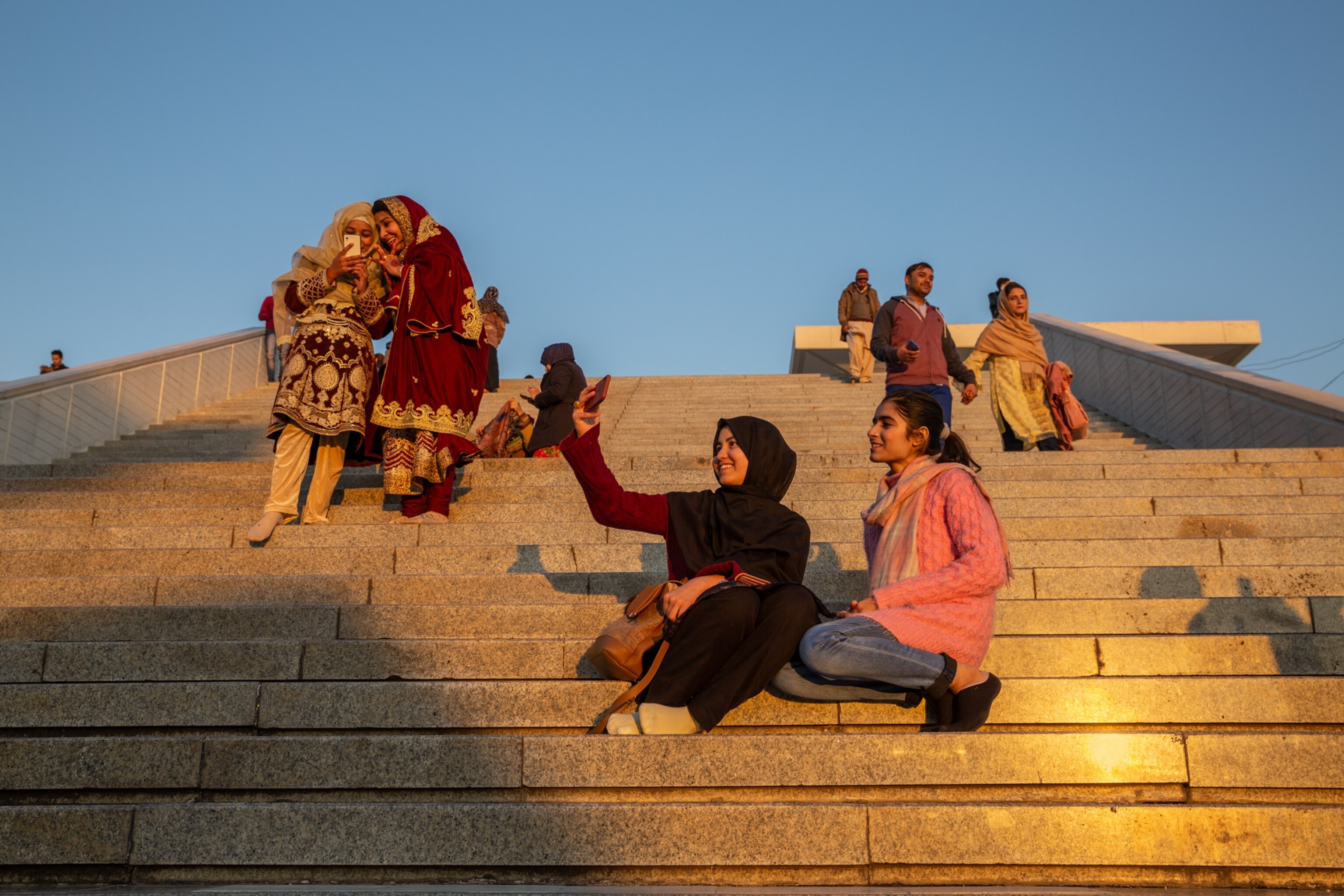
Farheen, who has only one name, is a Hazara, a member of an Afghan ethnic group and Shiite religious minority that has been persecuted, discriminated against, and massacred by rival ethnic groups, the Taliban, and other religious extremists for more than a century. Poverty and waves of war and violence in Afghanistan pushed many Hazaras out of the country.
In the 1960s Farheen’s grandparents crossed into Pakistan. They settled in Quetta, now home to some half a million Hazaras. Most live in one of two walled enclaves, penned in by police checkpoints as well as perpetual fear of violence. Since 2003, hundreds, perhaps thousands, of Hazaras in Quetta have been killed in targeted attacks and bombings. Hazara culture can be brutally patriarchal. “They talk about honor killing in a very casual way,” Farheen says, referring to the practice of men killing women they believe have shamed the family. “It scares me.”

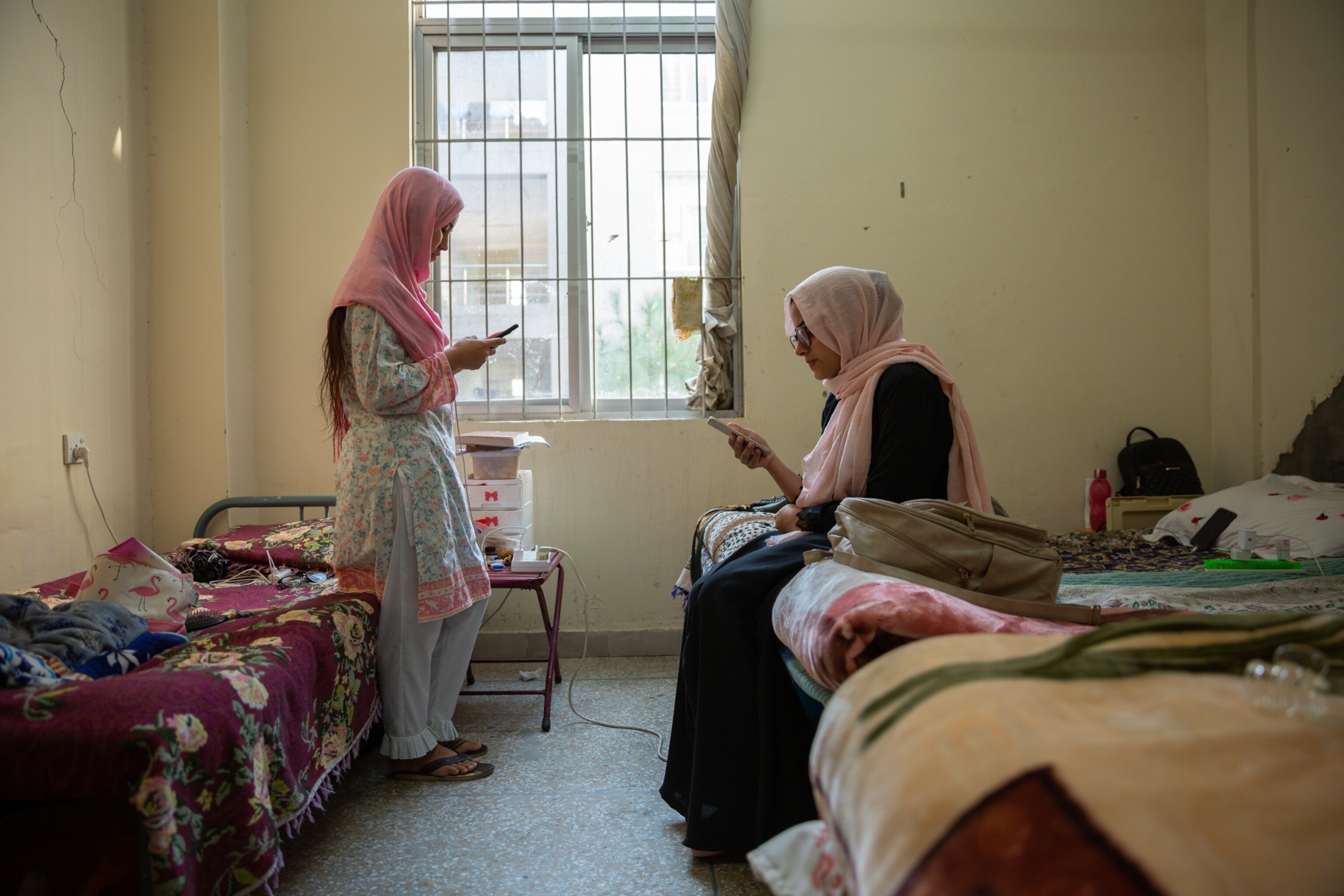
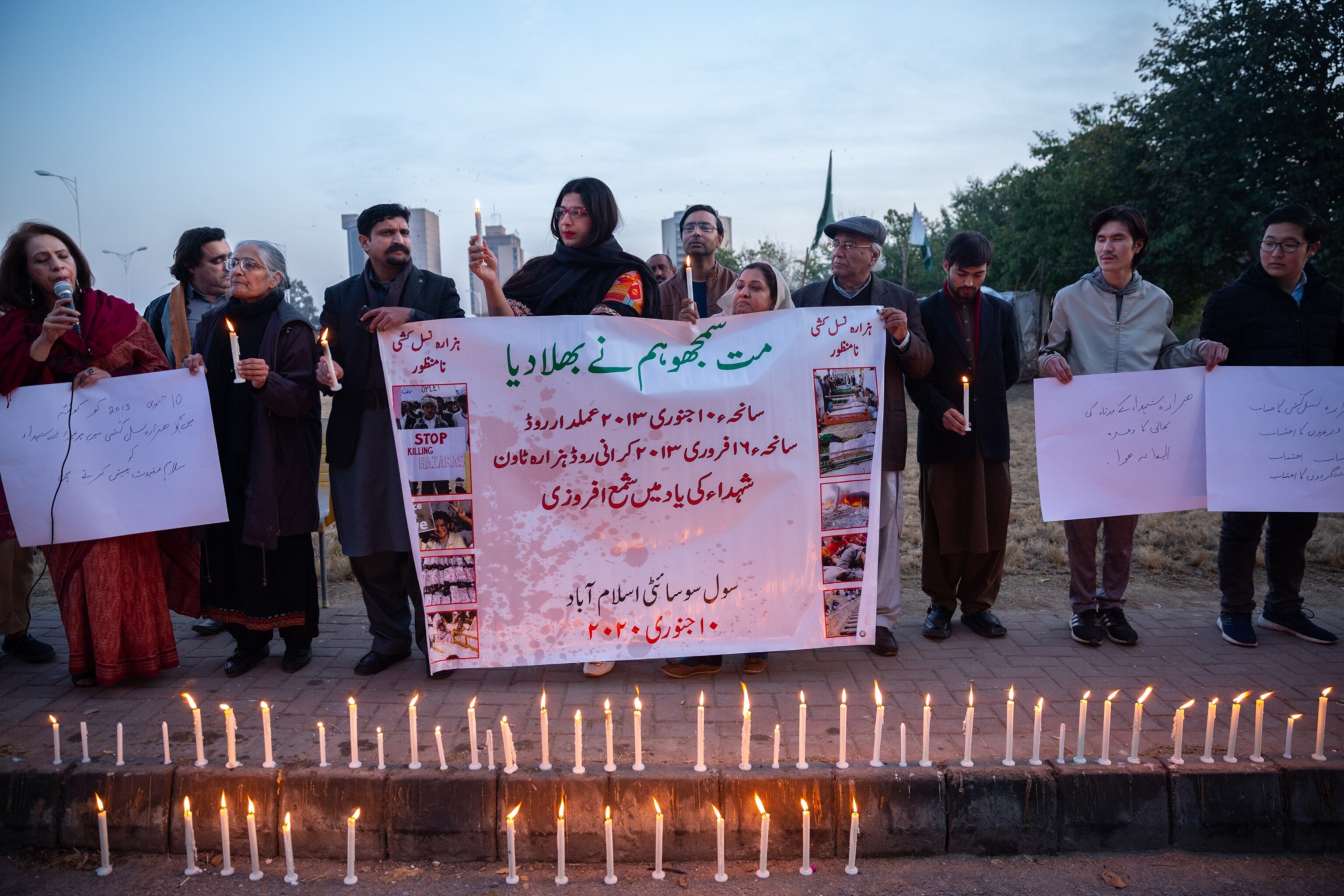
As Farheen puts it, “When you go to Quetta, your mind starts to close in. Your mind and heart both.” But, she might have added, when you venture away from Quetta, your mind and heart open up. Hazaras chafing against the strictures of life in Quetta may decide that to have a future, they must migrate to countries such as Australia, Iran, and Turkey. For many young Hazaras in Quetta, education has been their path to new confidence, and to freedom. In the Hazara interpretation of Islamic values, education is socially desirable and a religious imperative—a lifelong pursuit for women as well as men. For Farheen that meant leaving Quetta, in 2017, to study literature at the National University of Modern Languages in Islamabad, Pakistan’s capital.
There, more than 400 miles from home, Farheen says her fears diminished. She began taking the bus to classes and going to bustling public places. She became more open-minded. When she first heard of K-pop, the musical genre from South Korea, she dismissed it. “The boys looked like girls, and they had makeup on,” she says. But the catchy songs got her attention. She started paying attention to the lyrics, and soon she was hooked. She says she feels bad now for being judgmental. “K-pop has helped me a lot in being accepting towards new ideas.”


Farheen became curious about Korean culture. She studied the language and practiced K-pop dances. The groups sang about homophobia, mental health, and the difficulties of being a teenager, which helped her emerge from years of anxiety and depression.
She sees her foray into Islamabad as just the first step in discovering a world beyond the confines of Quetta. After graduation, she’d like to visit Canada, maybe study dance in the U.S., or tour Afghanistan, her Hazara homeland. She can imagine living in South Korea. Above all, Farheen is on a path toward freedom from her past and the weight of her culture’s history of persecution. Where she really wants to go, Farheen says, is “somewhere nobody knows me.” Back to top
Chapter 8. The Art of Healing: A Yemeni refugee in the Netherlands finds solace through her photography.
Photographs by Thana Faroq
It was 2017, three years into the civil war in Yemen, when photographer Thana Faroq, then 28, sought asylum in the Netherlands.
In Sanaa, Yemen’s capital and Thana’s home city, armed Houthi rebel militias had taken control and were marching through the streets. A few months later, air strikes by the Saudi-led coalition backing the deposed Yemeni government were killing hundreds of civilians and reducing neighborhoods to rubble. Meanwhile, in the southern city of Taizz, shelling damaged her grandfather’s house. Relatives fled the fighting there and piled into her mother’s house in downtown Sanaa, where bombs blew out windows and scattered glass on the floors.
“My husband and I were in a great danger,” Thana says. In their apartment about three miles from her mother’s house, they pulled their mattress into the space between the bathroom and the kitchen, the only windowless place where they could be safe from glass projectiles. “We would go to sleep not knowing if we would be alive by the morning,” she says.
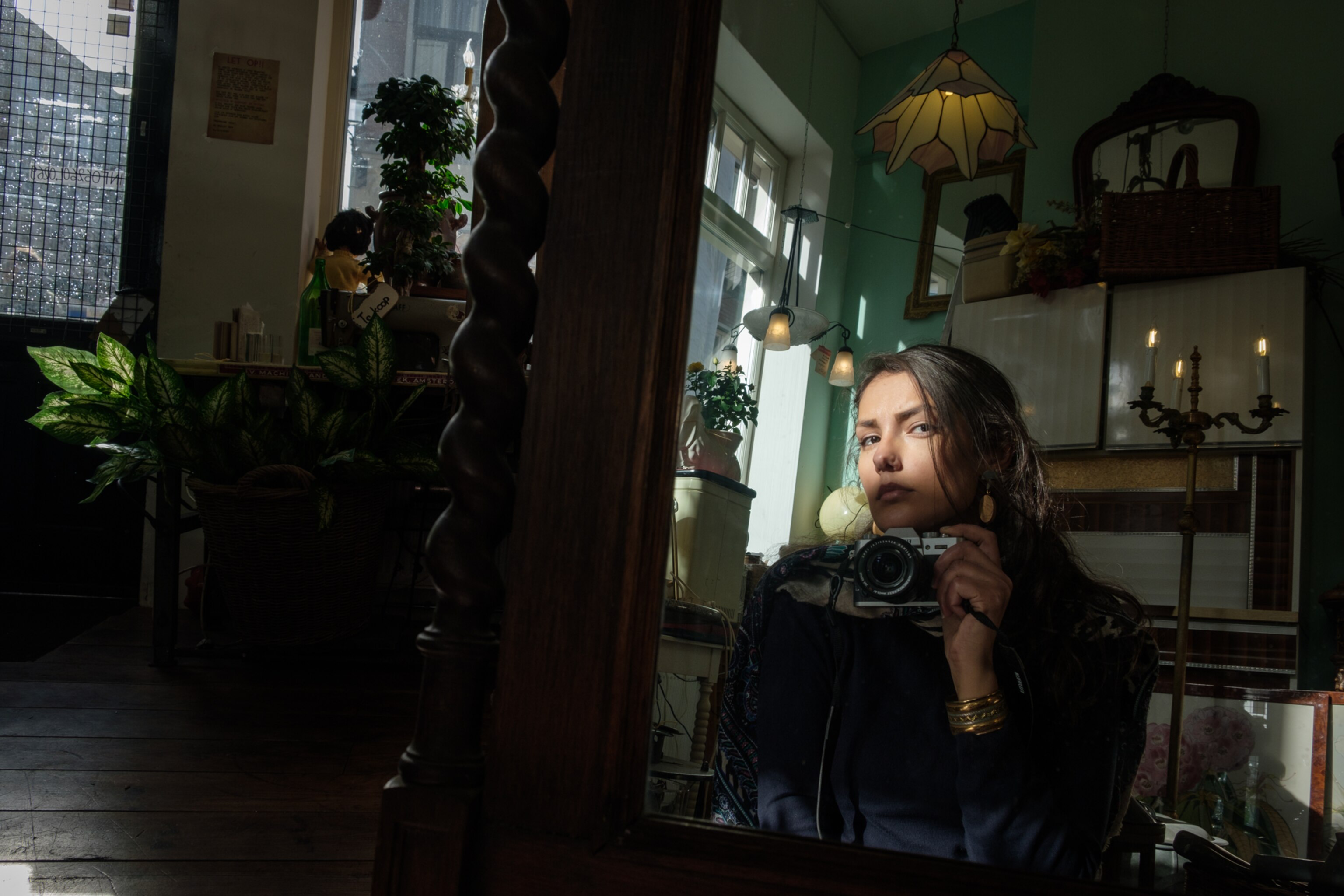
Thana says she first dedicated herself to photography when she returned to Sanaa in 2013 after graduating from college in Massachusetts.
She turned her camera to the streets of her city and to the faces of her fellow Yemenis. Photography became a way “to reconnect with the place” after she’d gotten used to life on her liberal college campus in the United States. Yemen is “a very, very male-dominated society,” she says, but the camera gave her a sense of freedom and allowed her to assert an identity beyond the conventional, limited expectations for women as wives, mothers, daughters.
After war broke out in 2014, Thana says she avoided documenting the “madness and the destruction. If I photograph it, then it’s real,” she says. Instead she sought out the normalcy of daily life as a way to deny—and defy—the grim reality: grainy black-and-white photos of veiled women walking in the street together; an old man reading the Quran; hot bread gathered into piles at a bakery; a child’s smile illuminated by a sparkler. That’s how Thana says she made the war “not real—it never happened.”

In 2016, Thana left home to pursue a master’s degree in documentary photography at the University of Westminster, in London. She believed the war would be over by the end of her academic year and that she’d return to Yemen.
“But that was a stupid dream,” she says. “War never ends—not easily, at least.” Rather than return to the violence in Yemen, Thana flew from London to Amsterdam, where her husband, Jamal Badr, was a student, and entered the Dutch asylum system in September 2017.
That year, 712,250 people from countries ranging from Syria, Iraq, and Afghanistan to Nigeria and Venezuela applied for asylum in the European Union, driven by violence and persecution. During the previous three years, more than three million people had sought asylum in the EU, many of them arriving on foot in unbroken lines of thousands, or washing ashore in Italy, Greece, and elsewhere in the Mediterranean on crowded dinghies.



Thana spent her first four months in the Netherlands moving from one asylum center to another as the government processed her claim, eventually approved for five years, after which Thana can apply for permanent residency and citizenship.
As she grappled with the dislocation and uncertainty of her new life, she reached again for her camera. She photographed the stark, institutional spaces of the asylum centers: the heavy steel doors in one that used to be a prison, the beams of light falling across a row of tables, and the simple bed in the room she shared with a couple of other asylum seekers. “In a way I was trying to analyze my emotional interior landscape through the physicality of things,” Thana says. The solidity of these buildings somehow helped her confront the reality that the Netherlands, not Yemen, was now her home.
Thana says the day she left the security of the asylum center for an apartment in The Hague, where Jamal joined her, was one of trepidation and fear. She had to rebuild her life. “I need to reestablish my existence, I need to heal from traumatic memories, I need to get used to the absence of loved ones,” she remembers thinking. “The list was long at that point,” she says.


Thana’s photography has allowed her to accept disruption and chaos in her life, and three years after her arrival in the Netherlands, it has provided a path toward acceptance in Dutch society. She says that getting assignments, even mundane ones such as photographing a bridge or a university trip for a magazine, affirms that at least on the professional level, she isn’t an outsider.
Thana is still struggling to learn the language, but she marvels at the tolerance of the Dutch people she meets, their willingness to open up to her in ways that make her feel connected. “I can form a home here. Not right away but eventually,” she says. “I’m happy.”
When Thana led a photography workshop for refugees funded by the Centraal Museum, in Utrecht, she was able to articulate another role the camera has played for her: as a tool for healing. She saw that sharing her photographs with others—who like her are haunted by memories, scarred by harrowing journeys, or nursing the ache of being far from home—helped them acknowledge their pain.
This simple act gave them courage, Thana says. “When you share your pain to others, it can start to feel empowering. You’re not the only one.”
The Pulitzer Center has created a companion curriculum for middle and high schoolers.
Related Topics
You May Also Like
Go Further
Animals
- Octopuses have a lot of secrets. Can you guess 8 of them?
- Animals
- Feature
Octopuses have a lot of secrets. Can you guess 8 of them? - This biologist and her rescue dog help protect bears in the AndesThis biologist and her rescue dog help protect bears in the Andes
- An octopus invited this writer into her tank—and her secret worldAn octopus invited this writer into her tank—and her secret world
- Peace-loving bonobos are more aggressive than we thoughtPeace-loving bonobos are more aggressive than we thought
Environment
- This ancient society tried to stop El Niño—with child sacrificeThis ancient society tried to stop El Niño—with child sacrifice
- U.S. plans to clean its drinking water. What does that mean?U.S. plans to clean its drinking water. What does that mean?
- Food systems: supporting the triangle of food security, Video Story
- Paid Content
Food systems: supporting the triangle of food security - Will we ever solve the mystery of the Mima mounds?Will we ever solve the mystery of the Mima mounds?
- Are synthetic diamonds really better for the planet?Are synthetic diamonds really better for the planet?
- This year's cherry blossom peak bloom was a warning signThis year's cherry blossom peak bloom was a warning sign
History & Culture
- Strange clues in a Maya temple reveal a fiery political dramaStrange clues in a Maya temple reveal a fiery political drama
- How technology is revealing secrets in these ancient scrollsHow technology is revealing secrets in these ancient scrolls
- Pilgrimages aren’t just spiritual anymore. They’re a workout.Pilgrimages aren’t just spiritual anymore. They’re a workout.
- This ancient society tried to stop El Niño—with child sacrificeThis ancient society tried to stop El Niño—with child sacrifice
- This ancient cure was just revived in a lab. Does it work?This ancient cure was just revived in a lab. Does it work?
- See how ancient Indigenous artists left their markSee how ancient Indigenous artists left their mark
Science
- Jupiter’s volcanic moon Io has been erupting for billions of yearsJupiter’s volcanic moon Io has been erupting for billions of years
- This 80-foot-long sea monster was the killer whale of its timeThis 80-foot-long sea monster was the killer whale of its time
- Every 80 years, this star appears in the sky—and it’s almost timeEvery 80 years, this star appears in the sky—and it’s almost time
- How do you create your own ‘Blue Zone’? Here are 6 tipsHow do you create your own ‘Blue Zone’? Here are 6 tips
- Why outdoor adventure is important for women as they ageWhy outdoor adventure is important for women as they age
Travel
- This royal city lies in the shadow of Kuala LumpurThis royal city lies in the shadow of Kuala Lumpur
- This author tells the story of crypto-trading Mongolian nomadsThis author tells the story of crypto-trading Mongolian nomads
- Slow-roasted meats and fluffy dumplings in the Czech capitalSlow-roasted meats and fluffy dumplings in the Czech capital







